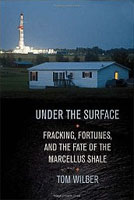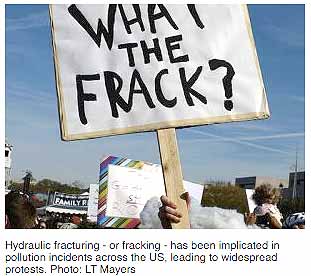Biblio
Fast Food Energy: Mom and Dad’s Great American Gas Rush.
Neil Zusman
Wilber, Tom. Under the Surface: Fracking, Fortunes and the Fate of the Marcellus Shale. Ithaca: Cornell University Press, 2012. Print.
Hydrofracking’s proposed a massive industrial transformation on a huge swath of the rural Northeastern U.S. and has divided communities and sparked an intense public debate touching on our method of economics, law making and enforcement. The book under review, Under the Surface, is one of less than 100 books published on the subject of hydraulic fracturing or fracking. Author Tom Wilber covered the environmental beat for Binghamton, N.Y.’s Press & Sun Bulletin.
Even George W. Bush said in a Presidential speech, that "Americans are addicted to oil". In my opinion, we are also addicted to natural gas and it is being pushed by the industry and abetted by govenments. A Theory of Rational Addiction (1988) by economists Gary Becker and Kevin Murphy, argued that shooting heroin is a logical choice when all you're giving up is a crappy existence. 1
Time’s humorist, Joel Stein, wrote about “Instant Gratification”. 2 Has everything in our culture become humorous? The controversy over how fast to develop the natural gas that lies beneath the Northeastern U.S. has not had the privilege of humor that Stein brings to his observations on self-gratification, or his penchant to deliver it in his own narcissistic, Seinfeld-esque 'cult of personality' idiom. Nevertheless, the fatter we all get craving our Big Macs, carbonated corn syrup, and drugs; the richer a few of us will become. The longer we are told to believe that hydrofracking is, in Terry Engeldr's words, 'a Christmas present for America', the more we will accept it as inevitable.
 3
3
It took an insider at the cigarette industry to finally confirm what the Surgeon General was trying to tell us 30 years earlier. And yet, the labels and warnings and widespread anti-smoking campaigns will not keep me from my craving. I may need a cigarette today and I am sure that I can get it. I don’t have that app that shows me what I will look like when I’m 80. Stein’s app would change my picture of the 80 year old me posted electronically on my fridge each time I eat a jelly glazed doughnut. The app for the cigarette smoker – would likewise factor the algorithms of that gratification. And our energy craving…trouble is, the math guys don’t have the data for that one.
In fact, so much of this stuff has been covered up and fabricated, that it’s hard to get any real data at all. The University of Pennsylvania had to eat crow over “The Penn State Report”. 4
“Graham Spanier, president of the university received a letter from an advocacy group complaining that the so-called Penn State report confused academic research with propaganda by its industry sponsors.”
…Spanier ordered William Easterling, dean of the college that published the report, to address the complaint. A few weeks later, Saxton (president of the Board of Responsible Drilling Alliance) received a reply from Easterling conceding that an internal review “found flaws in the way the report was written and presented to the public.” The fact that the report failed to identify its sponsor was a “clear error”. 5(p98)
 6
6
None of this stuff is illegal though. It’s a free market. As if that were everything.
Investors are satisfied with the way a cigarette or sugar doughnut or Big Mac works on our brain. Is that funny? Tom Wilber asks if will it be boom or bust and cites the work of Janette Barth.5(p101) Susan Christopherson and Ned Rightor, in "How Should We Think About the Economic Consequences of Shale Gas Drilling?" 7 have also wondered about that in a Park Foundation funded study. Who to believe?
Will our children grow up to be gas engineers or scholars, musicians or maids in the halls of the energy elite? We want them to be prepared. Will they be able to compete in the free market? And what about nature? What is a life worth? The EPA has put a valuation on it. 8 It’s worth about 7.9 million dollars. Is that chump change?
Humor is a challenge that may not be begged of Mr. Wilber’s reporting. He never intended his book to be funny. He gets both ends of the story on flowback, which are recovered fracturing fluids. According to the EPA’s web page, “Hydraulic Fracturing Background Information”, 9 disposal options for flowback include discharge into surface water or underground injection. Treatment is typically performed by wastewater treatment facilities. How companies deal with the disposal of the millions of gallons per well of waste-water produced in the gas extraction process is apparently well-known and regulated, but Wilber reveals that
“…There was something else that bothers Ken [Ely]. He hadn’t anticipated the wells on his land would produce so much waste. This included not only the spent chemical solution used to stimulate each well, but tens of millions of gallons of brine and whatever else came up from the holes. The flowback was supposed to be treated and disposed of at plants equipped to handle it, yet nobody could tell Ken exactly where those plants were.
…When I [Wilber] asked regulators where the flowback was being treated, they told me it was a question for the companies. When I asked company representatives, they told me, “It’s all regulated.” 5(p86)
Now that’s funny.
He interviewed Terry Engelder, who released the potential of the Marcellus Shale in the “Penn State Report”. He estimated there are 500 trillion cubic feet of natural gas waiting to be discovered. By Tony Ingraffea’s calculations, the Cornell engineering professor who has criticized the rush to develop the gas resource so quickly, it will take 400,000 wells to get to it, with each well requiring 5 million gallons of fresh water. That’s 2 trillion gallons of water going in, and somewhat less coming out that would need to be trucked, disposed of, or treated, or injected into the ground. Cayuga Lake, which is 40 miles long, 2 miles wide, and has a maximum depth of 435 feet, contains a total of 2.5 trillion gallons of water. 10
Wilber’s book reminds us how the facts of the water draw are not just about measuring the water usage and arguing those numbers, the huge impact that hundreds of thousands of truck trips on county roads will have on rural communities will be catastrophic, notwithstanding the composition of the wastewater itself.
The Marcellus Rush is all humorless self-indulgence, fancy landmen with Texan drawls and cowboy hats who look like your grandfather; engineers and scholars who think they’ve discovered the next big thing; and then the one after the big thing that will save us from the next big thing. Wilber gives us the Terry Engelder character, larger than life:
“He thought of the Marcellus discovery as a Christmas present for America; and on his drive home, after days of thinking about the possibilities, he was given to playing the Radetzky March by Johann Strauss…” 5(p96)
Somewhere in Washington, EPA Director Lisa Jackson’s speechwriter, tunes her Cello, and begins to play Bach’s Solos for Cello. Have you listened to those speeches? 11
If my life is so crappy that I don’t care if I smoke a pack a day or shoot heroin, whose job is it to stop me? I can buy any brand I want. Some brands even offer healthy alternatives. If I live in a poor neighborhood and can’t get a supermarket nearby, the government might have a program to encourage a market to open so I won’t have to live on Wendy’s or Big Macs. We like this stuff, we eat it to obesity and vote for it with our dollars; but the U.S. government tells me that I need a better diet, more choices. When it comes to energy, I can use natural gas, or… natural gas. I can put gasoline in my tank, or gasoline… People are buying electric cars. Maybe the trend is shifting.
“I asked Hanger where natural gas fit into his vision of green energy. It was better than coal, he said, the mining of which destroys mountaintops and the burning of which produces CO2 gases and mercury that accumulate in the food chain. In his view, a surge in the development and demand for alternatives, including solar panels, is imminent, due mostly to China’s burgeoning interest in the industry. “The baby has been born,” he said. "China is intent on building solar panels for the world. Those changes will come and those changes will be rapid – less than five years." 5(p204)
The cult of personality, as portrayed so eloquently in this important book, may be in need of a sense of humor and the self-deprecating sarcastic one-liner to make them marketable, but they have brought out our need to think about energy, the best thing our planet of humankind needs.
At one end of the spectrum were characters who
“…embraced the industry as an expression of old-fashioned free enterprise…At the other end of the spectrum were those who saw the industry as a relic of grandfather clauses and cronyism that dated to a period of predatory exploitation, when fantastical deals were pitched by door-to-door peddlers, manufacturing waste was buried in lagoons on private property, and unions were nonexistent. The middle ground was occupied by an untold number of consumers used to cheap plentiful energy, and property owners, who had their worries but also were able to calculate how much a mineral rights lease might be worth.” 5(p104)
Wilber draws the sides in as divisive and rude a public debate as one might expect to see on Fox TV. I don’t know why it hasn’t been picked up as a reality show yet, but it may be soon. Stu Gruskin, former asst. head of the NYS DEC admires civil discourse on his blog.12 He sounds like a sweet anachronism. I bet each side of this debate would like to call each other “big fat idiots” the way Al Franken tells it in his book on Rush Limbaugh13 or in Lies – and the Lying Liars who Tell Them, investigating the fabrications published by Bill O’Reilly, Ann Coulter, and Sean Hannity. One of Franken’s big ideas in Lies is that even good journalists contribute to the lie, taking at face value the reporting of their colleagues and re-iterating the report without investigation. 14 Wilber investigates.
References
1. Murphy KM, Becker GS. A Theory of Rational Addiction. Journal of Political Economy. 1988;96(4):675-700.
2. Stein J. "Instant Gratification." Time. 2012. Available at: http://www.time.com/time/magazine/article/0,9171,2113162,00.html [Accessed May 2, 2012].
3. Zusman N. Mashup of Hubbard 1, 6-H, 5-H, Springville, PA by Helen Slottje and Homer Simpson Doughnut. 2012. Available at: /frack_files/frac-pond-Helen-Slottie.jpg [Accessed April 28, 2012].
4. Glass I. This American Life Search Archive 440: Game Changer Transcript. Available at: http://www.thisamericanlife.org/radio-archives/episode/440/transcript [Accessed May 2, 2012].
5. Wilber T. Under the surface : fracking, fortunes and the fate of the Marcellus Shale. Ithaca: Cornell University Press; 2012.
6. Guariglia J. Cancer - Rogue Cells | Photo by Justin Guariglia. Available at: http://science.nationalgeographic.com/science/health-and-human-body/huma... [Accessed May 2, 2012].
7. Christopherson S, Rightor N. Working Paper Series: A Comprehensive Economic Impact Analysis of Natural Gas Extraction in the Marcellus Shale | How Should We Think About the Economic Consequences of Shale Gas Drilling? 2011. Available at: http://www.greenchoices.cornell.edu/downloads/development/marcellus/Marc....
8. Appelbaum B. "A Life’s Value May Depend on the Agency, but It’s Rising." The New York Times. 2011. Available at: http://www.nytimes.com/2011/02/17/business/economy/17regulation.html?_r=... [Accessed February 17, 2011].
9. U.S. Environmental Protection Agency (EPA): Office of Ground Water and Drinking Water OW. U.S. Environmental Protection Agency (EPA): Hydraulic Fracturing Study (2010-2012). Available at: http://water.epa.gov/type/groundwater/uic/class2/hydraulicfracturing/ind... [Accessed April 13, 2010].
10. Cayuga Lake Watershed Network. 2005. Available at: http://www.cayugalake.org/network/faq.php [Accessed May 2, 2012].
11. Jackson L. Lisa P. Jackson, EPA (lisapjackson) on Twitter. 2010. Available at: http://twitter.com/lisapjackson [Accessed January 11, 2011].
12. Gruskin S. Stuart Gruskin - Google+ - It's refreshing to read about public officials that are... Stuart Gruskin - Google+. 2011. Available at: https://plus.google.com/115541440669480452148/posts#11554144066948045214... [Accessed May 2, 2012].
13. Franken A. Rush Limbaugh is a big fat idiot and other observations. New York: Delacorte Press; 1996.
14. Franken A. Lies : and the lying liars who tell them : a fair and balanced look at the Right. New York: Dutton; 2003.
See also: Wilber, Tom. “Shale Gas Review.” Shale Gas Review, 2011. http://tomwilber.blogspot.com/.
The U.S. Chamber of Commerce is controlled by Big Polluters, poisons politics with its dirty money, and opposes every single effort to curb climate pollution.
“The U.S. Chamber Doesn’t Speak For Me” campaign is designed to expose the Chamber’s dirty business in Washington D.C., and discredit their efforts to delay the kind of bold action we need to create a clean energy economy and a safe climate future.
For more information, check out their Frequently Asked Questions page.
See: Eaarth: Making a Life on a Tough New Planet | 350.org Founder Bill McKibben
See: As climate crime continues, who are we sending to jail? Tim DeChristopher?
"Of the 84,000 chemicals in commercial use in the United States -- from flame retardants in furniture to household cleaners -- nearly 20 percent are secret, according to the Environmental Protection Agency, their names and physical properties guarded from consumers and virtually all public officials under a little-known federal provision."
The gas stored in the Marcellus Shale formation is the subject of desperate drilling to secure US domestic energy supplies. But the process involved - hydraulic fracturing - is the focus of a bitter dispute over environmental damage and community rights.
It is a timeless patchwork of small dairy farms and endless hills, emblazoned with the blood-red tints of an autumnal Pennsylvania forest. Set against this sleepy backdrop, however, the constant convoys of water trucks rumbling along the deserted country roads suggest something profound is taking place. This is ‘fracking’ country, the latest frontier in America’s desperate search for fossil fuels.
Pioneered by companies such as Halliburton, high-volume horizontal slickwater fracturing – otherwise known as hydraulic fracturing, or simply fracking – involves the drilling of horizontal wells that are then injected with large volumes of water, sand and chemicals at high pressure to open up rock fractures and help propel rock-trapped gas back to the surface.
Professor Anthony Ingrafea, one of the world's leading experts on fracture mechanics, based at Cornell University, told the Ecologist:
...there is an overriding urgency to slow down the fracking rush. 'I'm not anti-oil and gas. What I'm against is an industry that is so out of control in using a new technology that does not have proper regulation, and enforcement of regulation, that they're riding roughshod over a large segment of the population.'
Universal Well Services is one of the large companies being investigated by the U.S. House Energy and Commerce Committee to see if the gas extraction method known as hydraulic fracturing, or fracking, is a hazard to groundwater drinking supplies.
According to its website, Universal is a premier source for hydraulic fracturing, cementing, nitrogen and acidizing services in the Appalachian Basin.
With its corporate headquarters in Meadville, Pa, Universal Well Services, Inc has grown from 200 employees in 2002, to over 800 employees at the end of 2007. Universal Well Services is a division of Patterson-UTI, and the parent company of Eastern Reservoir Services.
Universal’s services in the Appalachian Basin include hydraulic fracturing, as well as acidizing, cementing and nitrogen services. Specialty services include engineering, chemical cleaning, jetting and high pressure pumping.
Several million gallons of "frack" fluid for each well return to the surface as a heavy brine, far saltier than seawater. Disposal of these new volumes of brine is a challenge.
So far, well operators or their agents have been hauling most of the frack flowback to Ohio for underground injection, according to Peterson, because salt removal is expensive and only two Class II, or brine disposal, wells were permitted by West Virginia's Underground Injection Control program.
Now, though, nine commercial brine disposal injection wells are permitted, and seven are operating. Several more are in the permitting pipeline.
The DEP has not in the past required well operators to report their water management in detail.
See: Desalination of Oil Field Brine
See: Gas wells' leftovers may wash into Ohio | Columbus Dispatch Politics
because there is nothing natural about what the natural gas extraction process invented by Halliburton does to water, air, & living things
Includes extensive background information and petition.
See article on Eminent Domain.
See: Is Your Unleased Property Facing Compulsory Integration?
Site contains link to Dr. Ronald E. Bishop, Sustainable Otsego. "Beyond MSDS: A Review of Hazardous Materials Used by New York’s Natural Gas Industry." Cooperstown, NY. September 18, 2009.
"The New York Department of Environmental Conservation (DEC), in response to a Freedom of Information Law request from the Committee to Preserve the Finger Lakes, sent material safety data sheets (MSDS’s) for 48 products permitted for use in the drilling and development of natural gas wells in New York. These are posted online by the Finger Lakes chapter of the Sierra Club.
From these and many other documents, Steve Coffman of the Committee to Preserve the Finger Lakes, developed a wonderful article: "The Safety of Fracturing Fluids – A Quantitative Assessment".
Speaker of the House Nancy Pelosi's (D-CA) Newsroom Web Page. Includes links to Energy & Commerce Commitee website. The American Clean Energy and Security Act (2009).
For the other side of the Energy debate, see John Boehner's Blog.
Question and Answer period starts at 52:00. See: Potential Gas Committee reports unprecedented increase in magnitude of U.S. natural gas resource base.
(January 20, 2010) John Curtis, Professor of Geochemistry and Director of the Potential Gas Agency at the Colorado School of Mines, discusses a broad range of perspectives on the state of U.S. shale gas reserves and resources along with the industries and technologies that are involved in extracting and bringing these energy resources to market.
![]() PRESS CONFERENCE: Senator Boxer to Hold Press Conference on Murkowski Proposal to Overturn EPA Global Warming Endangerment Finding.
PRESS CONFERENCE: Senator Boxer to Hold Press Conference on Murkowski Proposal to Overturn EPA Global Warming Endangerment Finding.
Thursday, January 21, 2010
U.S. Senator Barbara Boxer (D-CA), Chairman of the Senate Environment and Public Works Committee, will be joined by other Members of the EPW Committee and public health and environmental leaders to discuss Senator Lisa Murkowski’s (R-AK) proposal which would strip the authority under the Clean Air Act to protect children and families from carbon pollution.
The Subcommittee on Energy and Environment will hold a hearing entitled, "Endocrine Disrupting Chemicals in Drinking Water: Risks to Human Health and the Environment," on Thursday, February 25, 2010, at 9:30 a.m. in room 2322 of the Rayburn House Office Building.
This hearing will examine the science and regulation of endocrine disruptors that may be found in sources of drinking water. Posted Tuesday, 23 February 2010. See TEDX — The Endocrine Disruption Exchange.
INVITED WITNESSES:
- Jim Jones, Deputy Assistant Administrator, Office of Prevention, Pesticides and Toxic Substances, Environmental Protection Agency
- Linda S. Birnbaum, Ph.D., D.A.B.T., A.T.S., Director, National Institutes of Environmental Health Sciences
- Gina Solomon, M.D., M.P.H., Senior Scientist, Natural Resources Defense Council
- Christopher J. Borgert, Ph.D., President and Principal Scientist, Applied Pharmacology and Toxicology, Inc.
Oil And Gas Development: Increased Permitting Activity Has Lessened BLM's Ability to Meet Its Environmental Protection Responsibilities
GAO-05-418 June 17, 2005
Highlights Page (PDF) Full Report (PDF, 70 pages) Accessible Text Recommendations (HTML)
Summary
Rising U.S. energy consumption and concerns about dependency on foreign energy sources have prompted the administration to aggressively pursue domestic oil and gas production, including production on public lands, which in turn has generated concern that the impacts of this activity may compromise the use of public land for other purposes.
GAO determined:
(1) the extent to which the level of oil and gas development on public lands managed by the Bureau of Land Management (BLM) has changed in recent years, and how the change has affected BLM's ability to mitigate impacts;
(2) what policy changes related to oil and gas development BLM recently made and how these policies affected BLM's environmental mitigation activities; and
(3) what challenges BLM faces in managing its oil and gas program.BLM's ability to meet its environmental mitigation responsibilities for oil and gas development has been lessened by a dramatic increase in oil and gas operations on federal lands over the past 6 years.
On March 18, 2010, The U.S. Environmental Protection Agency (EPA) announced that it will conduct a comprehensive research study to investigate the potential adverse impact that hydraulic fracturing may have on water quality and public health.
Natural gas plays a key role in our nation’s clean energy future and the process known as hydraulic fracturing is one way of accessing that vital resource.
There are concerns that hydraulic fracturing may impact ground water and surface water quality in ways that threaten human health and the environment.
EPA Scientific Advisory Board (SAB) Environmental Engineer Committee Hydraulic Fracturing Research Plan Review. 4/7/2010- 4/8/2010. The St Regis, 923 16th Street, NW, Washington DC 20006.
2011 EPA Hydraulic Fracturing Study Plan Review Panel Selections.
Disclaimer Although not required to do so, EPA generally posts public comments submitted to the SAB, Clean Air Science Advisory Committee (CASAC) or Council and their subcommittees on the internet to make them easily available to the public. Posting of public comments is not an Agency endorsement of, or agreement with, any information or viewpoints presented in the public comment, nor is it an Agency endorsement of the quality or correctness of such information and viewpoints. The SAB Staff intends to remove the public comments from the internet upon finalization of the pertinent advisory activity. Once removed, the comments may be obtained by contacting the Designated Federal Officer (DFO).
|
Edward Hanlon 202-343-9946 hanlon.edward@epa.gov |
|
Background Document- Evaluation Impacts to Underground Sources of DW by HF of Coalbed Methane Reservoirs. (PDF, 1 pp., 12,672 bytes) |
|
| Agency-provided Background Material | Background Document- Modern Shale Gas Development in the United States-A Primer. (PDF, 116 pp., 5,359,127 bytes) |
| Agency-provided Background Material | Background Document-Unconventional Gas Shales Development Technology and Policy Issues. (PDF, 53 pp., 2,546,992 bytes) |
| Agency Briefing Material | EPA Presentation Materials, 4-6-10. (PDF, 22 pp., 776,783 bytes) |
| Charge to the Committee | Charge Questions - Advice on Hydraulic Fracturing Research . (PDF, 3 pp., 45,693 bytes) |
| Public Comments | List of Public Speakers-Hydraulic Fracturing April 2010 Meeting as of 4-6-10. (PDF, 1 pp., 17,113 bytes) |
| Public Comments | Oral Statement Submitted by Chad Bradley, Representing Chesapeake Energy Corporation, 4-7-10. (PDF, 4 pp., 1,350,622 bytes) |
| Public Comments | Oral Statement Submitted by Craig Segall, Representing Sierra Club, 4-5-10. (PDF, 5 pp., 81,937 bytes) |
| Public Comments | Oral Statement Submitted by Jennifer Peters, Representing Clean Water Network, 4-6-10. (PDF, 3 pp., 124,334 bytes) |
| Public Comments | Oral Statement Submitted by Keith Hastie, Representing US Fish and Wildlife Service, 4-7-10. (PDF, 2 pp., 433,041 bytes) |
| Public Comments | Oral Statement Submitted by Lauren Pagel, Representing EARTHWORKS, 4-7-10. (PDF, 2 pp., 17,787 bytes) |
| Public Comments | Oral Statement Submitted by Mary Krueger, Representing The Wilderness Society, 4-6-10. (PDF, 3 pp., 75,525 bytes) |
| Public Comments | Oral Statement Submitted by Mike Watts, Representing Halliburton Energy Services Inc., 4-6-10. (PDF, 6 pp., 72,197 bytes) |
| Public Comments | Oral Statement Submitted by Mr. Lee Fuller, Representing Independent Petroleum Association of America (IPAA) and Energy In Depth (EID), 3-28-10. (PDF, 3 pp., 46,255 bytes) |
| Public Comments | Oral Statement submitted by Mr. Richard Liroff, representing Investor Environmental Health Network, 3-26-10. (PDF, 6 pp., 85,739 bytes) |
| Public Comments | Oral Statement Submitted by Stephanie R. Meadows, Representing American Petroleum Institute, 4-6-10. (PDF, 5 pp., 26,559 bytes) |
| Public Comments | Presentation by Craig Segall, Representing Sierra Club, 4-5-10. (PDF, 9 pp., 333,895 bytes) |
| Public Comments | Presentation Submitted by Mary Krueger, Representing The Wilderness Society, 4-6-10. (PDF, 3 pp., 2,008,663 bytes) |
| Public Comments | Public Comments Submitted by Beth Pierce, 4-6-10. (PDF, 2 pp., 11,822 bytes) |
| Public Comments | Public Comments Submitted by Bill Podulka, 4-6-10. (PDF, 3 pp., 27,229 bytes) |
| Public Comments | Public Comments Submitted by David and Ginny Farmer, Dryden, NY, 4-6-10. (PDF, 1 pp., 8,764 bytes) |
| Public Comments | Public Comments Submitted by Debra Anderson, Representing Red Rock Pictures, 4-6-10. (PDF, 2 pp., 12,177 bytes) |
| Public Comments | Public Comments Submitted by Ellen Schmidt, Ithaca, New York, 4-5-10. (PDF, 1 pp., 8,462 bytes) |
| Public Comments | Public Comments Submitted by Fernando de Aragón, Representing Ithaca-Tompkins County Transportation Council, 4-5-10. (PDF, 4 pp., 65,781 bytes) |
| Public Comments | Public Comments Submitted by Frances Littin, Representing Sheldrake Point Winery, 4-6-10. (PDF, 1 pp., 400,153 bytes) |
| Public Comments | Public Comments Submitted by Harry Levine, representing Advocates for Springfield, 4-7-10. (PDF, 2 pp., 11,361 bytes) |
| Public Comments | Public Comments Submitted by Honorable Brad Henry, Governor of the State of Oklahoma, 3-25-10. (PDF, 1 pp., 58,570 bytes) |
| Public Comments | Public Comments Submitted by Hugh Kimball, Baldwinsville NY, 4-5-10. (PDF, 1 pp., 10,603 bytes) |
| Public Comments | Public Comments Submitted by Jan Zeserson, Ithaca, New York, 4-5-10. (PDF, 1 pp., 11,494 bytes) |
| Public Comments | Public Comments Submitted by Jill Wiener, Callicoon Center NY, 4-6-10. (PDF, 3 pp., 20,347 bytes) |
| Public Comments | Public Comments Submitted by Joe Wilson, Ithaca, NY, 4-5-10. (PDF, 5 pp., 47,843 bytes) |
| Public Comments | Public Comments Submitted by Kari Matsko, Representing Northeast Ohio Gas Accountability Project-NEOGAP, 4-6-10. (PDF, 13 pp., 746,003 bytes) |
| Public Comments | Public Comments Submitted by Karl Seeley, Representing Hartwick College, 4-5-10. (PDF, 1 pp., 9,090 bytes) |
| Public Comments | Public Comments Submitted by Ken Zeserson, Representing Town of Ulysses New York Planning Board, 4-5-10. (PDF, 50 pp., 567,832 bytes) |
| Public Comments | Public Comments Submitted by Kirk Glundal, Representing EarthEmbers, 4-6-10. (PDF, 1 pp., 8,789 bytes) |
| Public Comments | Public Comments Submitted by Marge Hubbert, Cortland New York, 4-5-10. (PDF, 1 pp., 11,935 bytes) |
| Public Comments | Public Comments Submitted by Marilyn Hunt, 4-6-10. (PDF, 7 pp., 374,498 bytes) |
| Public Comments | Public Comments Submitted by Marilyn Hunt, 4-7-10. (PDF, 1 pp., 8,519 bytes) |
| Public Comments | Public Comments Submitted by Mark Dunau, Representing Northeast Organic Farming Association of New York, and Delaware County Farm Bureau of New York, 4-7-10. (PDF, 3 pp., 25,930 bytes) |
| Public Comments | Public Comments Submitted by Martha Robertson, Representing Tompkins County Legislature, 4-5-10. (PDF, 4 pp., 98,977 bytes) |
| Public Comments | Public Comments Submitted by Martha Robertson, Representing Tompkins County Legislature, 4-8-10. (PDF, 8 pp., 211,284 bytes) |
| Public Comments | Public Comments Submitted by Michael P. Crall, Representing U.S. Army Corps of Engineers Pittsburgh District, 3-26-10. (PDF, 14 pp., 4,216,085 bytes) |
| Public Comments | Public Comments Submitted by Michael Scarna, Representing Trybe Inc., 4-6-10. (PDF, 2 pp., 106,094 bytes) |
| Public Comments | Public Comments Submitted by Michelle Bamberger, Representing Vet Behavior Consults, 4-6-10. (PDF, 2 pp., 15,088 bytes) |
| Public Comments | Public Comments Submitted by Mr. Ben Wallace, Representing Penneco Oil Company, 3-26-10. (PDF, 6 pp., 2,175,822 bytes) |
| Public Comments | Public Comments Submitted by Mr. Bob Bemis Representing Noble Energy, Inc., 3-29-10. (PDF, 4 pp., 51,412 bytes) |
| Public Comments | Public Comments Submitted by Mr. Bob Flournoy, Representing Energy Investment Partners-3-24-10. (PDF, 1 pp., 9,637 bytes) |
| Public Comments | Public Comments Submitted by Mr. Caswell F. Holloway, Representing New York City Department of Environmental Protection, 3-31-10. (PDF, 1 pp., 780,578 bytes) |
| Public Comments | Public Comments submitted by Mr. D. Gerow Baker, representing Interstate Oil and Gas Compact Commission-3-26-10. (PDF, pp., 2,957,003 bytes) |
| Public Comments | Public Comments submitted by Mr. Edwin P. Przybylowicz, Representing Seneca Lake Pure Waters Association, 3-27-10. (PDF, 15 pp., 2,524,294 bytes) |
| Public Comments | Public Comments Submitted by Mr. Gregory D. Russell, Representing the Ohio Oil and Gas Association, 3-29-10. (PDF, 7 pp., 1,394,322 bytes) |
| Public Comments | Public Comments Submitted by Mr. James F. Barre, Representing Keuka Lake Association, 3-29-10. (PDF, 2 pp., 18,257 bytes) |
| Public Comments | Public Comments Submitted by Mr. Jeff Zimmerman, Representing Damascus Citizens for Sustainability and Friends of the Upper Delaware River, 3-29-10. (PDF, 3 pp., 75,495 bytes) |
| Public Comments | Public Comments Submitted by Mr. Keith Curley, Representing Trout Unlimited, 3-29-10. (PDF, 1 pp., 194,585 bytes) |
| Public Comments | Public Comments Submitted by Mr. Mike Paque, representing Ground Water Protection Council, 3-26-10. (PDF, 1 pp., 32,007 bytes) |
| Public Comments | Public Comments Submitted by Mr. Robert Neid, Representing Schoharie Valley Watch, 4-2-10. (PDF, 1 pp., 9,536 bytes) |
| Public Comments | Public Comments Submitted by Mr. Steve Coffman, Representing Committee to Preserve the Finger Lakes, 3-26-10. (PDF, 4 pp., 23,286 bytes) |
| Public Comments | Public Comments Submitted by Mr. William Wegner, Representing Riverkeeper, Inc., 3-29-10. (PDF, 25 pp., 1,787,077 bytes) |
| Public Comments | Public Comments Submitted by Ms. Katherine Klaber, Representing Marcellus Shale Coalition, 3-29-10. (PDF, 3 pp., 97,101 bytes) |
| Public Comments | Public Comments Submitted by Ms. Kathleen M. Sgamma, Representing Independent Petroleum Association of Mountain States (IPAMS), 3-29-10. (PDF, 7 pp., 344,892 bytes) |
| Public Comments | Public Comments Submitted by Ms. Natalie Roy, Representing Clean Water Network, 3-29-10. (PDF, 6 pp., 120,366 bytes) |
| Public Comments | Public Comments Submitted by Oskar Schmidt, Ithaca, New York, 4-5-10. (PDF, 1 pp., 9,210 bytes) |
| Public Comments | Public Comments Submitted by Ramsay Adams, Representing Catskill Mountainkeeper, 4-6-10. (PDF, 4 pp., 23,009 bytes) |
| Public Comments | Public Comments Submitted by Ronald E. Bishop, Cooperstown, NY, 4-7-10. (PDF, 1 pp., 9,795 bytes) |
| Public Comments | Public Comments Submitted by Sandy Podulka, Brooktondale, NY, 4-7-10. (PDF, 9 pp., 59,415 bytes) |
| Public Comments | Public Comments Submitted by Sarah Gowin, Ithaca, New York, 4-5-10. (PDF, 1 pp., 12,707 bytes) |
| Public Comments | Public Comments Submitted by Scott M. Stringer, Representing Manhatten Borough, New York City, NY, 4-7-10. (PDF, 12 pp., 839,399 bytes) |
| Public Comments | Public Comments Submitted by Secretary of Energy Robert Wegener and Secretary of Environment J.D. Strong of the State of Oklahoma, 3-26-10. (PDF, 4 pp., 246,855 bytes) |
| Public Comments | Public Comments Submitted by Stephen L Dungan, Walton, NY, 4-5-10. (PDF, 2 pp., 15,423 bytes) |
| Public Comments | Public Comments Submitted by Stephen Penningroth, Ithaca, NY, 4-7-10. (PDF, 16 pp., 92,429 bytes) |
| Public Comments | Public Comments Submitted by Stuart Kemp, Representing Halliburton Energy Services Inc., 4-6-10. (PDF, 16 pp., 244,179 bytes) |
| Public Comments | Public Comments Submitted by Talia Lugacy, Hancock, NY, 4-6-10. (PDF, 3 pp., 131,129 bytes) |
| Public Comments | Public Comments Submitted byTom Noonan, Hancock, NY, 4-6-10. (PDF, 3 pp., 76,172 bytes) |
The UIC Program is responsible for regulating the construction, operation, permitting, and closure of injection wells that place fluids underground for storage or disposal.
This site provides information for owners and operators of injection wells and state regulators on how to safely operate injection wells to prevent contamination of underground drinking water resources.
See: A searchable database covering all EISs filed with EPA since January 2004.
See: Where You Live (EPA) Regional Contacts.
State UIC Programs have primary enforcement responsibility (or primacy) once their UIC programs have been approved by EPA. The UIC Program Primacy page provides information about the requirements for obtaining primacy and which states have been granted this authority.
The UIC Program requirements were developed by EPA and designed to be adopted by states, territories, and tribes. States, territories, and tribes can submit an application to EPA to obtain primary enforcement responsibility, or primacy.
Agencies that have been granted this authority oversee the injection activities in their states. The requirements for primacy programs are outlined in the UIC regulations at 40 CFR Part 145.


EPA regulates public water systems; it does not have the authority to regulate private drinking water wells. Approximately 15 percent of Americans rely on their own private drinking water supplies, and these supplies are not subject to EPA standards, although some state and local governments do set rules to protect users of these wells. Unlike public drinking water systems serving many people, they do not have experts regularly checking the water’s source and its quality before it is sent to the tap. These households must take special precautions to ensure the protection and maintenance of their drinking water supplies.
"...Check the paper or call your local planning or zoning commission for announcements about hearings or zoning appeals on development or industrial projects that could possibly affect your water.
Attend these hearings, ask questions about how your water source is being protected, and don't be satisfied with general answers. Make statements like "If you build this landfill, (just an example) what will you do to ensure that my water will be protected." See how quickly they answer and provide specifics about what plans have been made to specifically address that issue."















